HI5016 Report: Tariffs, Import Duties, and Their Effects
VerifiedAdded on 2020/01/23
|13
|3586
|41
Report
AI Summary
This report provides a comprehensive analysis of tariffs and import duties, exploring their multifaceted effects on industries and economies. It delves into the mechanisms of tariffs, including their impact on trade, consumer surplus, and government revenue. The report examines the effects of tariffs on domestic and foreign markets, considering factors like competition, price changes, and the potential for job losses. It also addresses the benefits and costs of tariffs, analyzing their influence on industries, the UK economy, and international trade agreements, such as those related to the European Union. The report uses economic theories and real-world examples to illustrate the complex interplay of tariffs and import duties in shaping the economic landscape. It examines the effects of tariffs on industries, consumers, and governments, including the impact on prices, demand, and employment. Furthermore, it provides an overview of the economic effects of tariffs, including consumption effect, redistribution effect, and income effects. The report concludes by highlighting the importance of understanding tariffs and import duties in the context of global trade and economic policy.

Tariff and Import
Duties
Duties
Paraphrase This Document
Need a fresh take? Get an instant paraphrase of this document with our AI Paraphraser
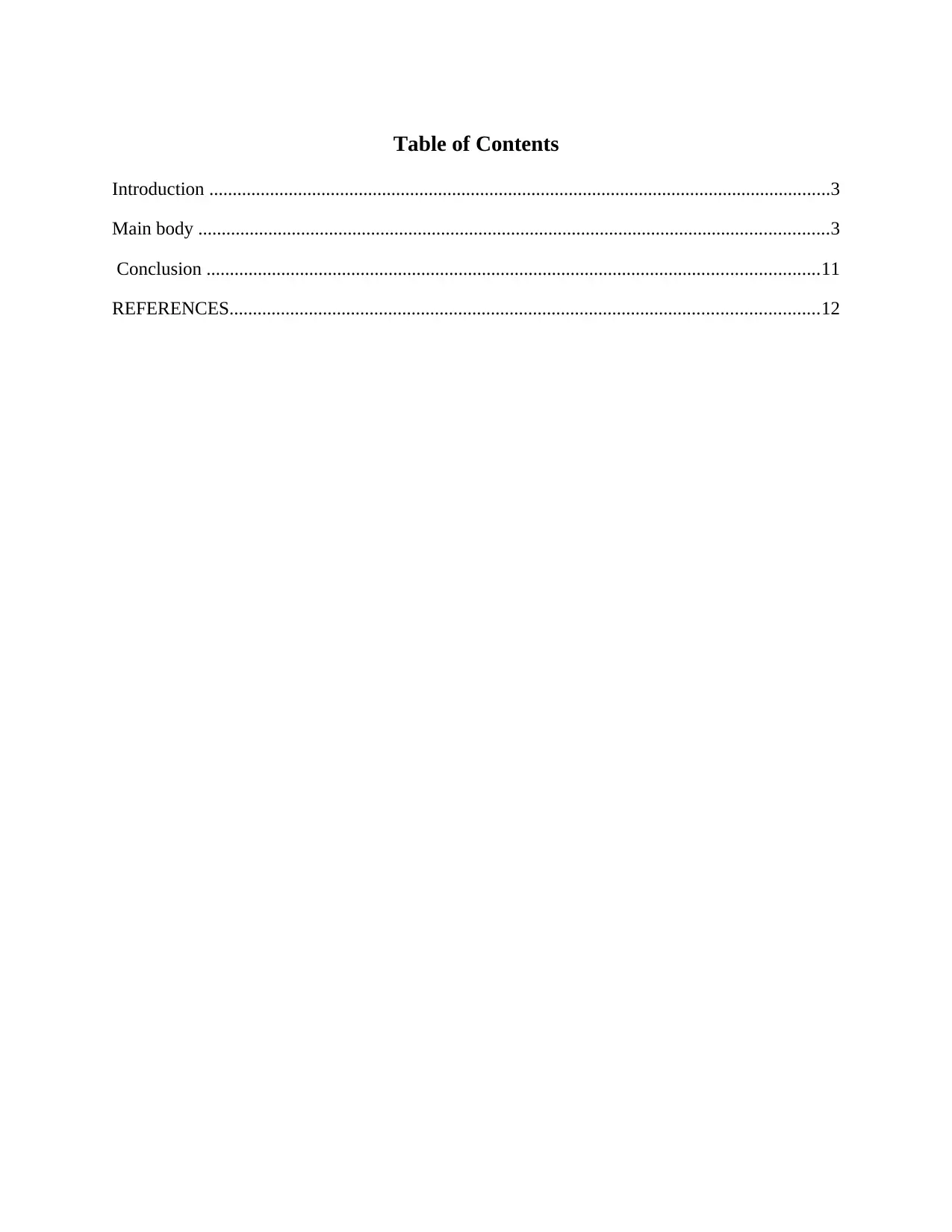
Table of Contents
Introduction .....................................................................................................................................3
Main body .......................................................................................................................................3
Conclusion ...................................................................................................................................11
REFERENCES..............................................................................................................................12
Introduction .....................................................................................................................................3
Main body .......................................................................................................................................3
Conclusion ...................................................................................................................................11
REFERENCES..............................................................................................................................12
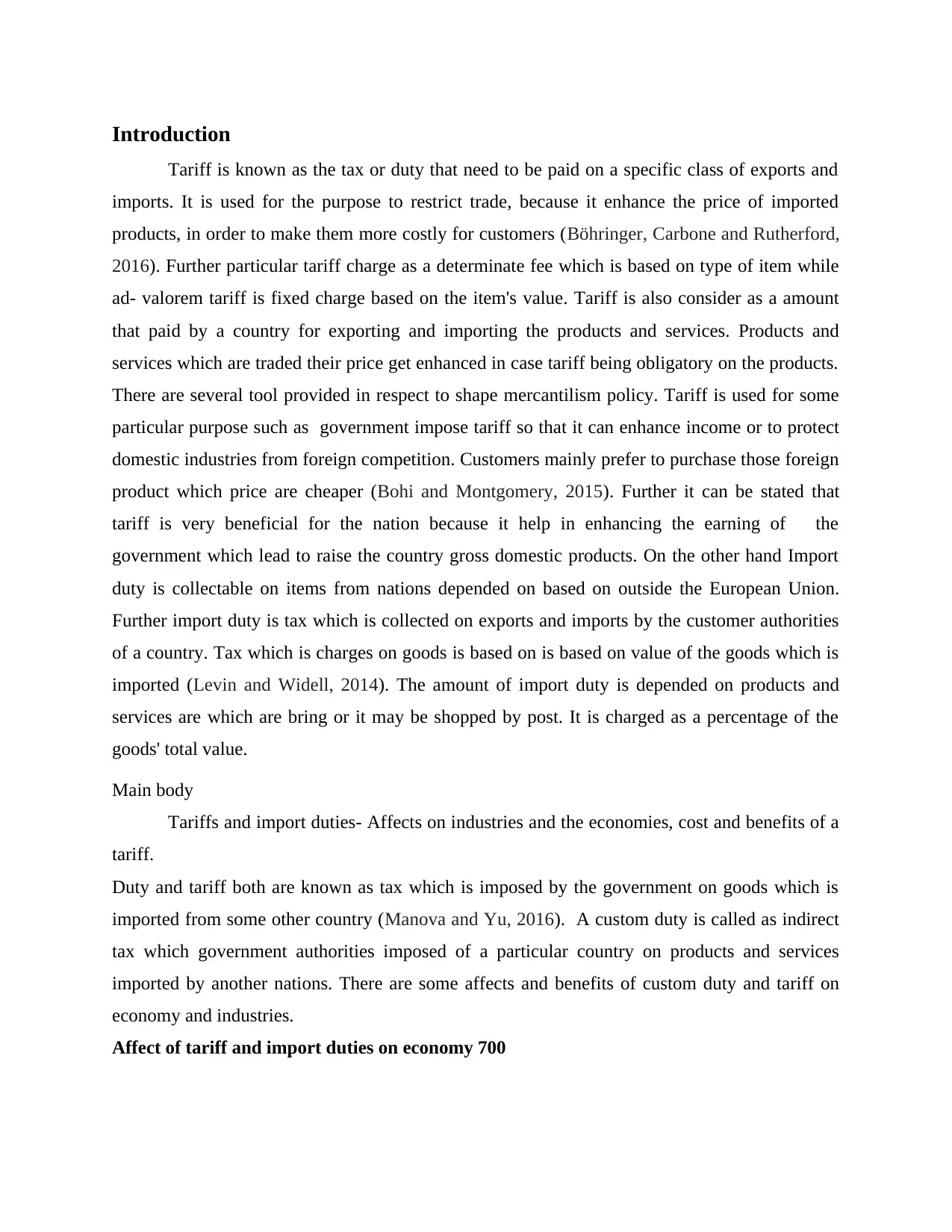
Introduction
Tariff is known as the tax or duty that need to be paid on a specific class of exports and
imports. It is used for the purpose to restrict trade, because it enhance the price of imported
products, in order to make them more costly for customers (Böhringer, Carbone and Rutherford,
2016). Further particular tariff charge as a determinate fee which is based on type of item while
ad- valorem tariff is fixed charge based on the item's value. Tariff is also consider as a amount
that paid by a country for exporting and importing the products and services. Products and
services which are traded their price get enhanced in case tariff being obligatory on the products.
There are several tool provided in respect to shape mercantilism policy. Tariff is used for some
particular purpose such as government impose tariff so that it can enhance income or to protect
domestic industries from foreign competition. Customers mainly prefer to purchase those foreign
product which price are cheaper (Bohi and Montgomery, 2015). Further it can be stated that
tariff is very beneficial for the nation because it help in enhancing the earning of the
government which lead to raise the country gross domestic products. On the other hand Import
duty is collectable on items from nations depended on based on outside the European Union.
Further import duty is tax which is collected on exports and imports by the customer authorities
of a country. Tax which is charges on goods is based on is based on value of the goods which is
imported (Levin and Widell, 2014). The amount of import duty is depended on products and
services are which are bring or it may be shopped by post. It is charged as a percentage of the
goods' total value.
Main body
Tariffs and import duties- Affects on industries and the economies, cost and benefits of a
tariff.
Duty and tariff both are known as tax which is imposed by the government on goods which is
imported from some other country (Manova and Yu, 2016). A custom duty is called as indirect
tax which government authorities imposed of a particular country on products and services
imported by another nations. There are some affects and benefits of custom duty and tariff on
economy and industries.
Affect of tariff and import duties on economy 700
Tariff is known as the tax or duty that need to be paid on a specific class of exports and
imports. It is used for the purpose to restrict trade, because it enhance the price of imported
products, in order to make them more costly for customers (Böhringer, Carbone and Rutherford,
2016). Further particular tariff charge as a determinate fee which is based on type of item while
ad- valorem tariff is fixed charge based on the item's value. Tariff is also consider as a amount
that paid by a country for exporting and importing the products and services. Products and
services which are traded their price get enhanced in case tariff being obligatory on the products.
There are several tool provided in respect to shape mercantilism policy. Tariff is used for some
particular purpose such as government impose tariff so that it can enhance income or to protect
domestic industries from foreign competition. Customers mainly prefer to purchase those foreign
product which price are cheaper (Bohi and Montgomery, 2015). Further it can be stated that
tariff is very beneficial for the nation because it help in enhancing the earning of the
government which lead to raise the country gross domestic products. On the other hand Import
duty is collectable on items from nations depended on based on outside the European Union.
Further import duty is tax which is collected on exports and imports by the customer authorities
of a country. Tax which is charges on goods is based on is based on value of the goods which is
imported (Levin and Widell, 2014). The amount of import duty is depended on products and
services are which are bring or it may be shopped by post. It is charged as a percentage of the
goods' total value.
Main body
Tariffs and import duties- Affects on industries and the economies, cost and benefits of a
tariff.
Duty and tariff both are known as tax which is imposed by the government on goods which is
imported from some other country (Manova and Yu, 2016). A custom duty is called as indirect
tax which government authorities imposed of a particular country on products and services
imported by another nations. There are some affects and benefits of custom duty and tariff on
economy and industries.
Affect of tariff and import duties on economy 700
⊘ This is a preview!⊘
Do you want full access?
Subscribe today to unlock all pages.

Trusted by 1+ million students worldwide
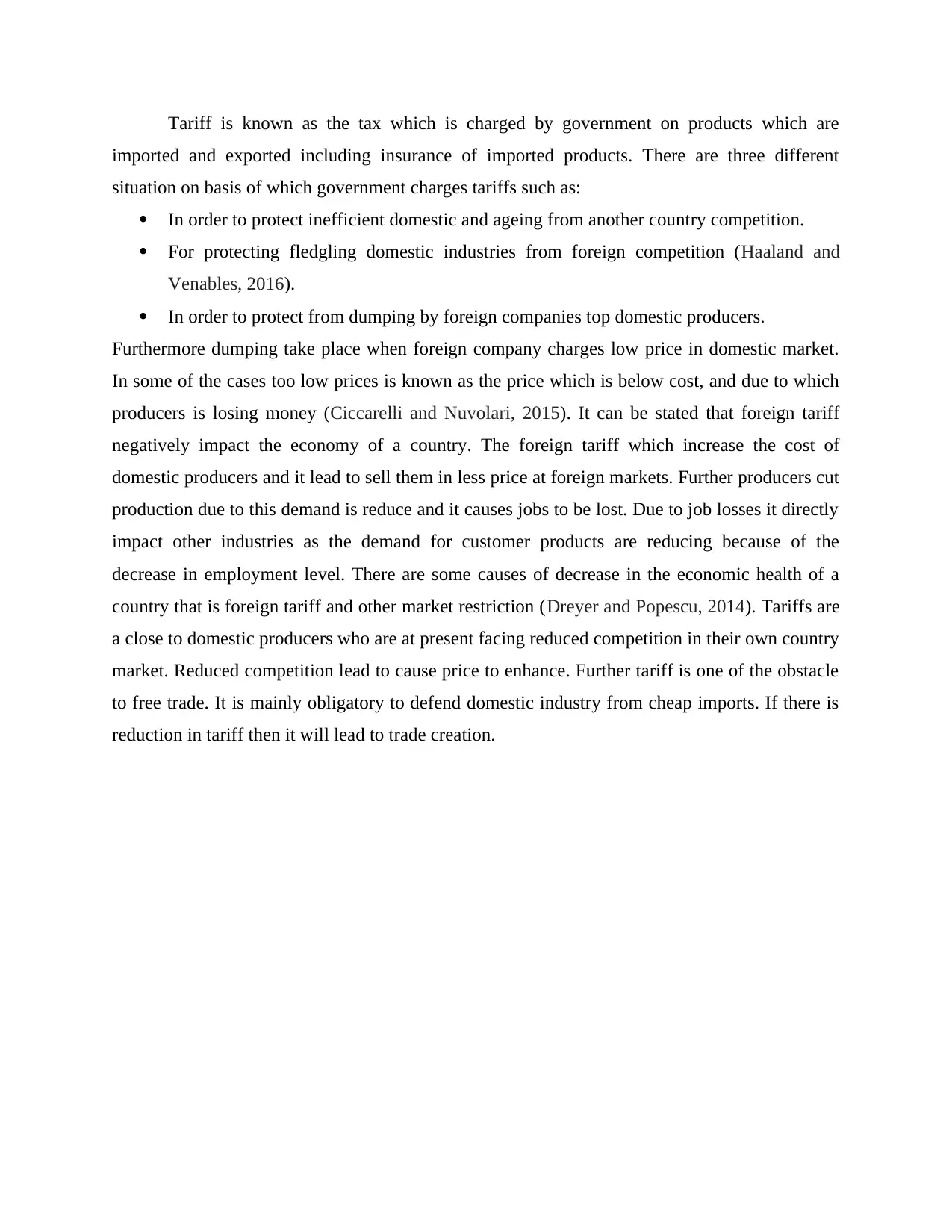
Tariff is known as the tax which is charged by government on products which are
imported and exported including insurance of imported products. There are three different
situation on basis of which government charges tariffs such as:
In order to protect inefficient domestic and ageing from another country competition.
For protecting fledgling domestic industries from foreign competition (Haaland and
Venables, 2016).
In order to protect from dumping by foreign companies top domestic producers.
Furthermore dumping take place when foreign company charges low price in domestic market.
In some of the cases too low prices is known as the price which is below cost, and due to which
producers is losing money (Ciccarelli and Nuvolari, 2015). It can be stated that foreign tariff
negatively impact the economy of a country. The foreign tariff which increase the cost of
domestic producers and it lead to sell them in less price at foreign markets. Further producers cut
production due to this demand is reduce and it causes jobs to be lost. Due to job losses it directly
impact other industries as the demand for customer products are reducing because of the
decrease in employment level. There are some causes of decrease in the economic health of a
country that is foreign tariff and other market restriction (Dreyer and Popescu, 2014). Tariffs are
a close to domestic producers who are at present facing reduced competition in their own country
market. Reduced competition lead to cause price to enhance. Further tariff is one of the obstacle
to free trade. It is mainly obligatory to defend domestic industry from cheap imports. If there is
reduction in tariff then it will lead to trade creation.
imported and exported including insurance of imported products. There are three different
situation on basis of which government charges tariffs such as:
In order to protect inefficient domestic and ageing from another country competition.
For protecting fledgling domestic industries from foreign competition (Haaland and
Venables, 2016).
In order to protect from dumping by foreign companies top domestic producers.
Furthermore dumping take place when foreign company charges low price in domestic market.
In some of the cases too low prices is known as the price which is below cost, and due to which
producers is losing money (Ciccarelli and Nuvolari, 2015). It can be stated that foreign tariff
negatively impact the economy of a country. The foreign tariff which increase the cost of
domestic producers and it lead to sell them in less price at foreign markets. Further producers cut
production due to this demand is reduce and it causes jobs to be lost. Due to job losses it directly
impact other industries as the demand for customer products are reducing because of the
decrease in employment level. There are some causes of decrease in the economic health of a
country that is foreign tariff and other market restriction (Dreyer and Popescu, 2014). Tariffs are
a close to domestic producers who are at present facing reduced competition in their own country
market. Reduced competition lead to cause price to enhance. Further tariff is one of the obstacle
to free trade. It is mainly obligatory to defend domestic industry from cheap imports. If there is
reduction in tariff then it will lead to trade creation.
Paraphrase This Document
Need a fresh take? Get an instant paraphrase of this document with our AI Paraphraser
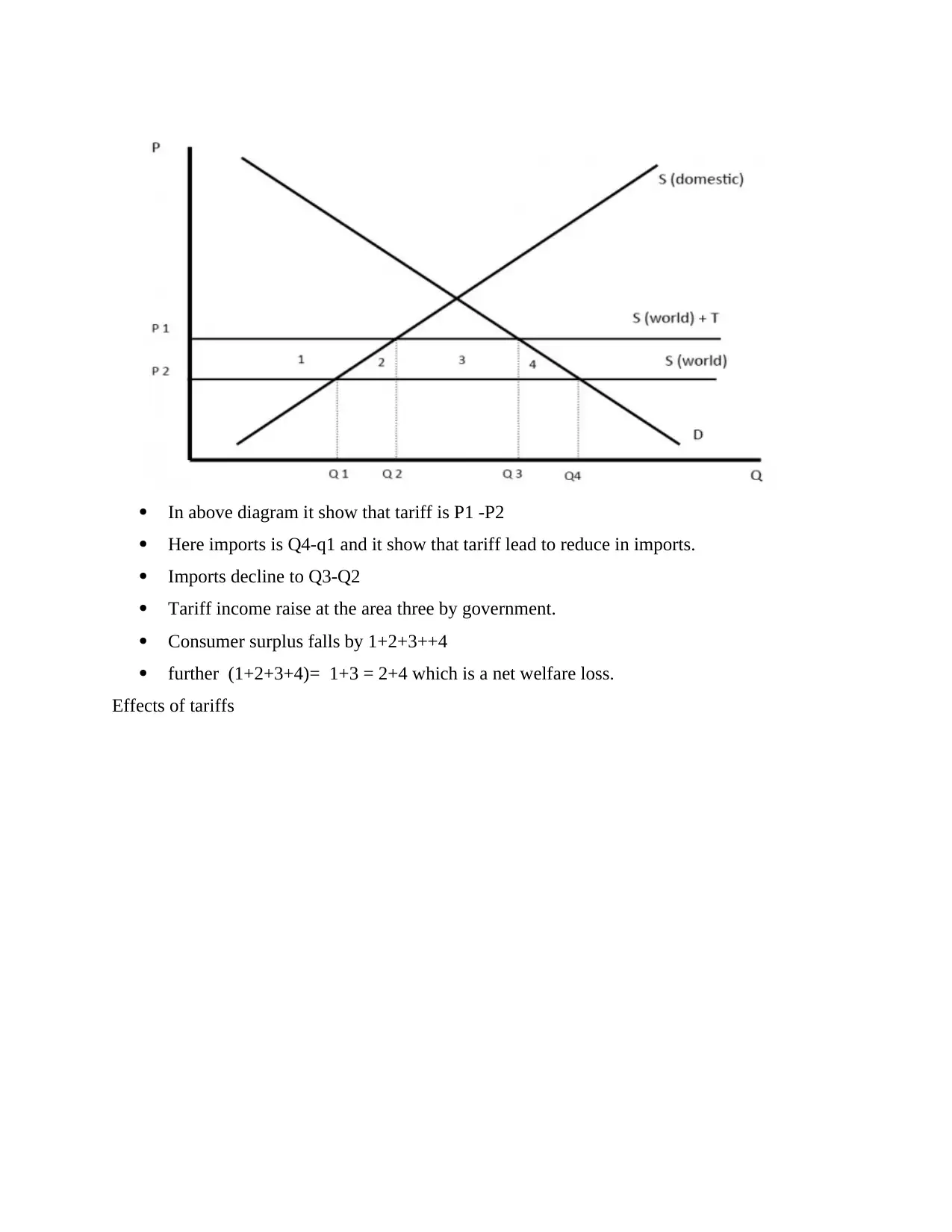
In above diagram it show that tariff is P1 -P2
Here imports is Q4-q1 and it show that tariff lead to reduce in imports.
Imports decline to Q3-Q2
Tariff income raise at the area three by government.
Consumer surplus falls by 1+2+3++4
further (1+2+3+4)= 1+3 = 2+4 which is a net welfare loss.
Effects of tariffs
Here imports is Q4-q1 and it show that tariff lead to reduce in imports.
Imports decline to Q3-Q2
Tariff income raise at the area three by government.
Consumer surplus falls by 1+2+3++4
further (1+2+3+4)= 1+3 = 2+4 which is a net welfare loss.
Effects of tariffs
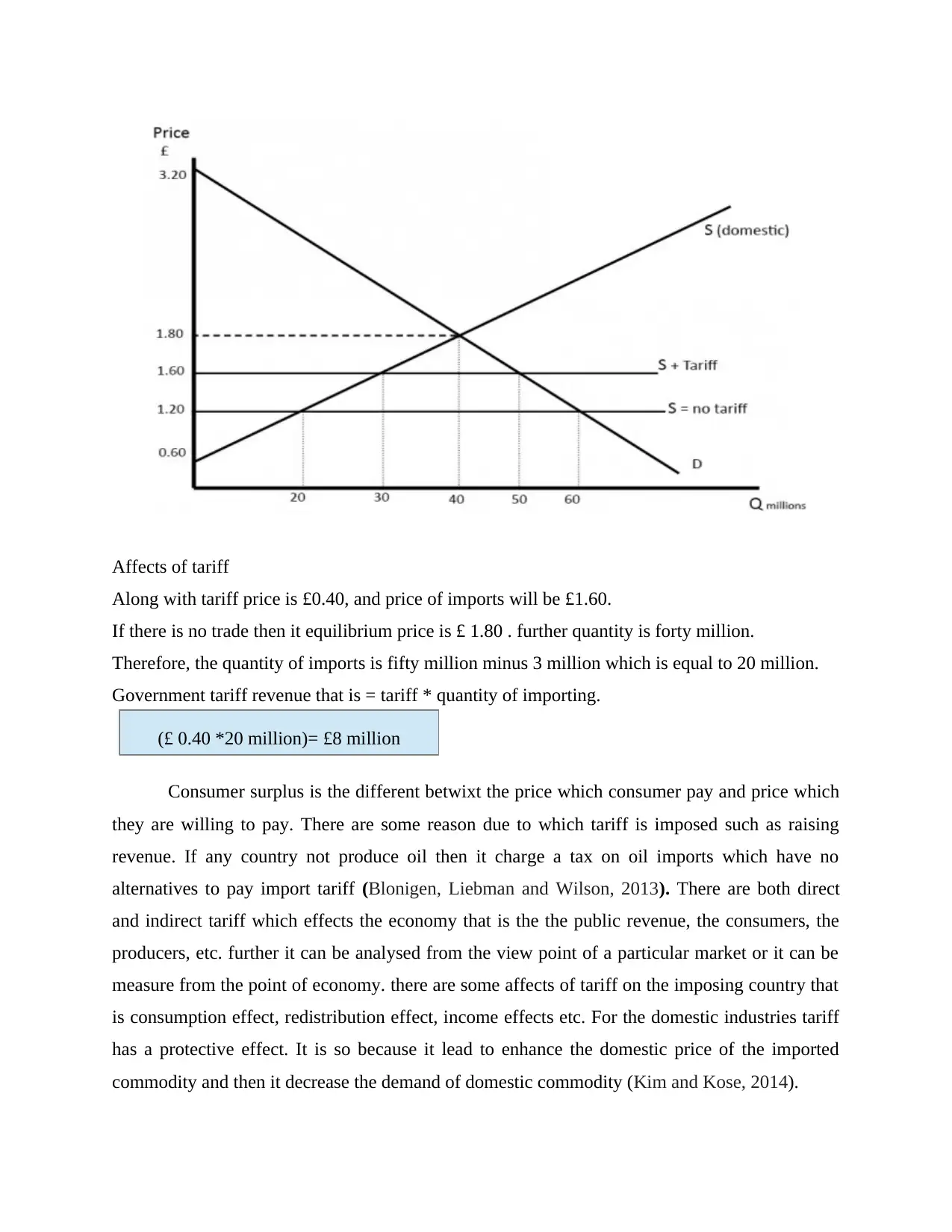
Affects of tariff
Along with tariff price is £0.40, and price of imports will be £1.60.
If there is no trade then it equilibrium price is £ 1.80 . further quantity is forty million.
Therefore, the quantity of imports is fifty million minus 3 million which is equal to 20 million.
Government tariff revenue that is = tariff * quantity of importing.
Consumer surplus is the different betwixt the price which consumer pay and price which
they are willing to pay. There are some reason due to which tariff is imposed such as raising
revenue. If any country not produce oil then it charge a tax on oil imports which have no
alternatives to pay import tariff (Blonigen, Liebman and Wilson, 2013). There are both direct
and indirect tariff which effects the economy that is the the public revenue, the consumers, the
producers, etc. further it can be analysed from the view point of a particular market or it can be
measure from the point of economy. there are some affects of tariff on the imposing country that
is consumption effect, redistribution effect, income effects etc. For the domestic industries tariff
has a protective effect. It is so because it lead to enhance the domestic price of the imported
commodity and then it decrease the demand of domestic commodity (Kim and Kose, 2014).
(£ 0.40 *20 million)= £8 million
Along with tariff price is £0.40, and price of imports will be £1.60.
If there is no trade then it equilibrium price is £ 1.80 . further quantity is forty million.
Therefore, the quantity of imports is fifty million minus 3 million which is equal to 20 million.
Government tariff revenue that is = tariff * quantity of importing.
Consumer surplus is the different betwixt the price which consumer pay and price which
they are willing to pay. There are some reason due to which tariff is imposed such as raising
revenue. If any country not produce oil then it charge a tax on oil imports which have no
alternatives to pay import tariff (Blonigen, Liebman and Wilson, 2013). There are both direct
and indirect tariff which effects the economy that is the the public revenue, the consumers, the
producers, etc. further it can be analysed from the view point of a particular market or it can be
measure from the point of economy. there are some affects of tariff on the imposing country that
is consumption effect, redistribution effect, income effects etc. For the domestic industries tariff
has a protective effect. It is so because it lead to enhance the domestic price of the imported
commodity and then it decrease the demand of domestic commodity (Kim and Kose, 2014).
(£ 0.40 *20 million)= £8 million
⊘ This is a preview!⊘
Do you want full access?
Subscribe today to unlock all pages.

Trusted by 1+ million students worldwide
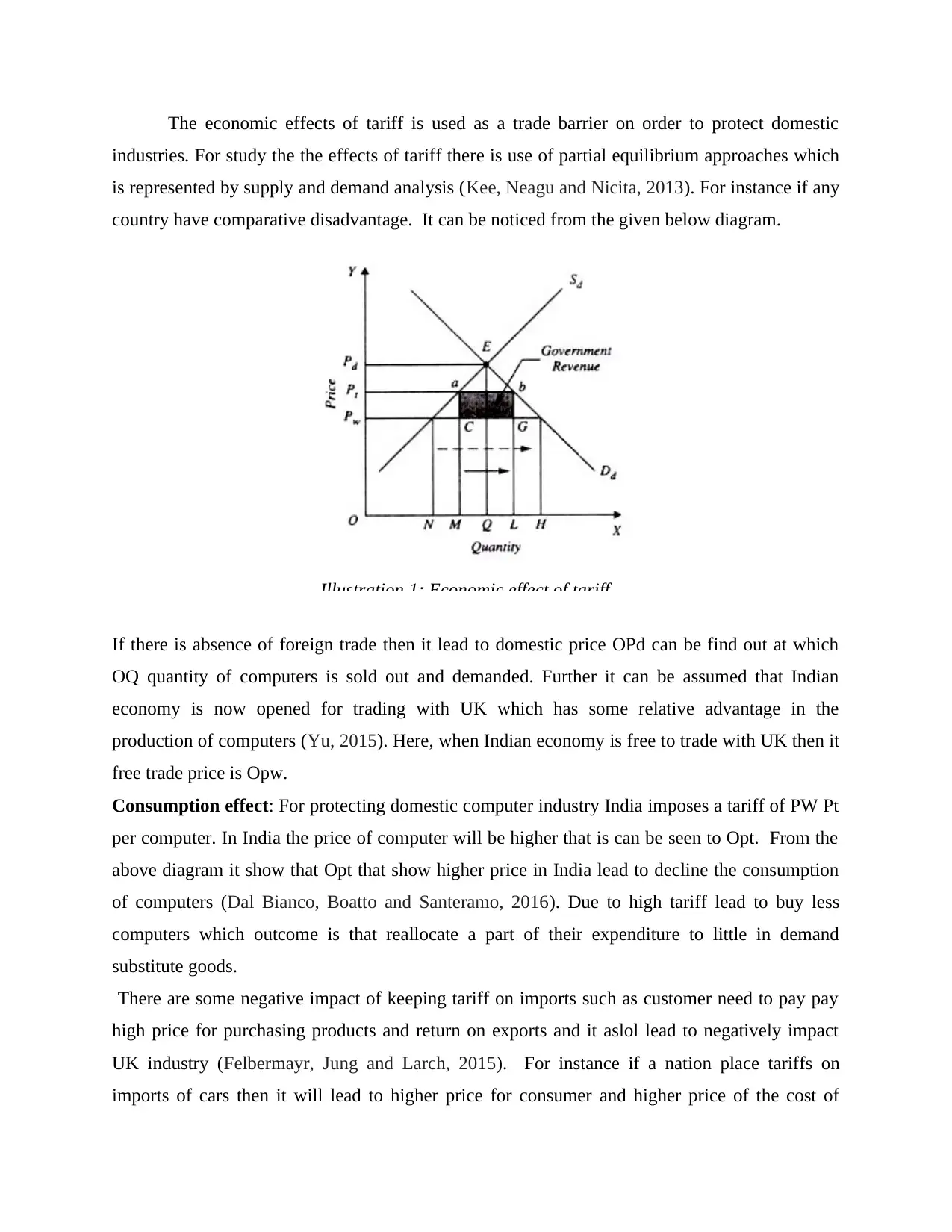
The economic effects of tariff is used as a trade barrier on order to protect domestic
industries. For study the the effects of tariff there is use of partial equilibrium approaches which
is represented by supply and demand analysis (Kee, Neagu and Nicita, 2013). For instance if any
country have comparative disadvantage. It can be noticed from the given below diagram.
If there is absence of foreign trade then it lead to domestic price OPd can be find out at which
OQ quantity of computers is sold out and demanded. Further it can be assumed that Indian
economy is now opened for trading with UK which has some relative advantage in the
production of computers (Yu, 2015). Here, when Indian economy is free to trade with UK then it
free trade price is Opw.
Consumption effect: For protecting domestic computer industry India imposes a tariff of PW Pt
per computer. In India the price of computer will be higher that is can be seen to Opt. From the
above diagram it show that Opt that show higher price in India lead to decline the consumption
of computers (Dal Bianco, Boatto and Santeramo, 2016). Due to high tariff lead to buy less
computers which outcome is that reallocate a part of their expenditure to little in demand
substitute goods.
There are some negative impact of keeping tariff on imports such as customer need to pay pay
high price for purchasing products and return on exports and it aslol lead to negatively impact
UK industry (Felbermayr, Jung and Larch, 2015). For instance if a nation place tariffs on
imports of cars then it will lead to higher price for consumer and higher price of the cost of
Illustration 1: Economic effect of tariff
industries. For study the the effects of tariff there is use of partial equilibrium approaches which
is represented by supply and demand analysis (Kee, Neagu and Nicita, 2013). For instance if any
country have comparative disadvantage. It can be noticed from the given below diagram.
If there is absence of foreign trade then it lead to domestic price OPd can be find out at which
OQ quantity of computers is sold out and demanded. Further it can be assumed that Indian
economy is now opened for trading with UK which has some relative advantage in the
production of computers (Yu, 2015). Here, when Indian economy is free to trade with UK then it
free trade price is Opw.
Consumption effect: For protecting domestic computer industry India imposes a tariff of PW Pt
per computer. In India the price of computer will be higher that is can be seen to Opt. From the
above diagram it show that Opt that show higher price in India lead to decline the consumption
of computers (Dal Bianco, Boatto and Santeramo, 2016). Due to high tariff lead to buy less
computers which outcome is that reallocate a part of their expenditure to little in demand
substitute goods.
There are some negative impact of keeping tariff on imports such as customer need to pay pay
high price for purchasing products and return on exports and it aslol lead to negatively impact
UK industry (Felbermayr, Jung and Larch, 2015). For instance if a nation place tariffs on
imports of cars then it will lead to higher price for consumer and higher price of the cost of
Illustration 1: Economic effect of tariff
Paraphrase This Document
Need a fresh take? Get an instant paraphrase of this document with our AI Paraphraser
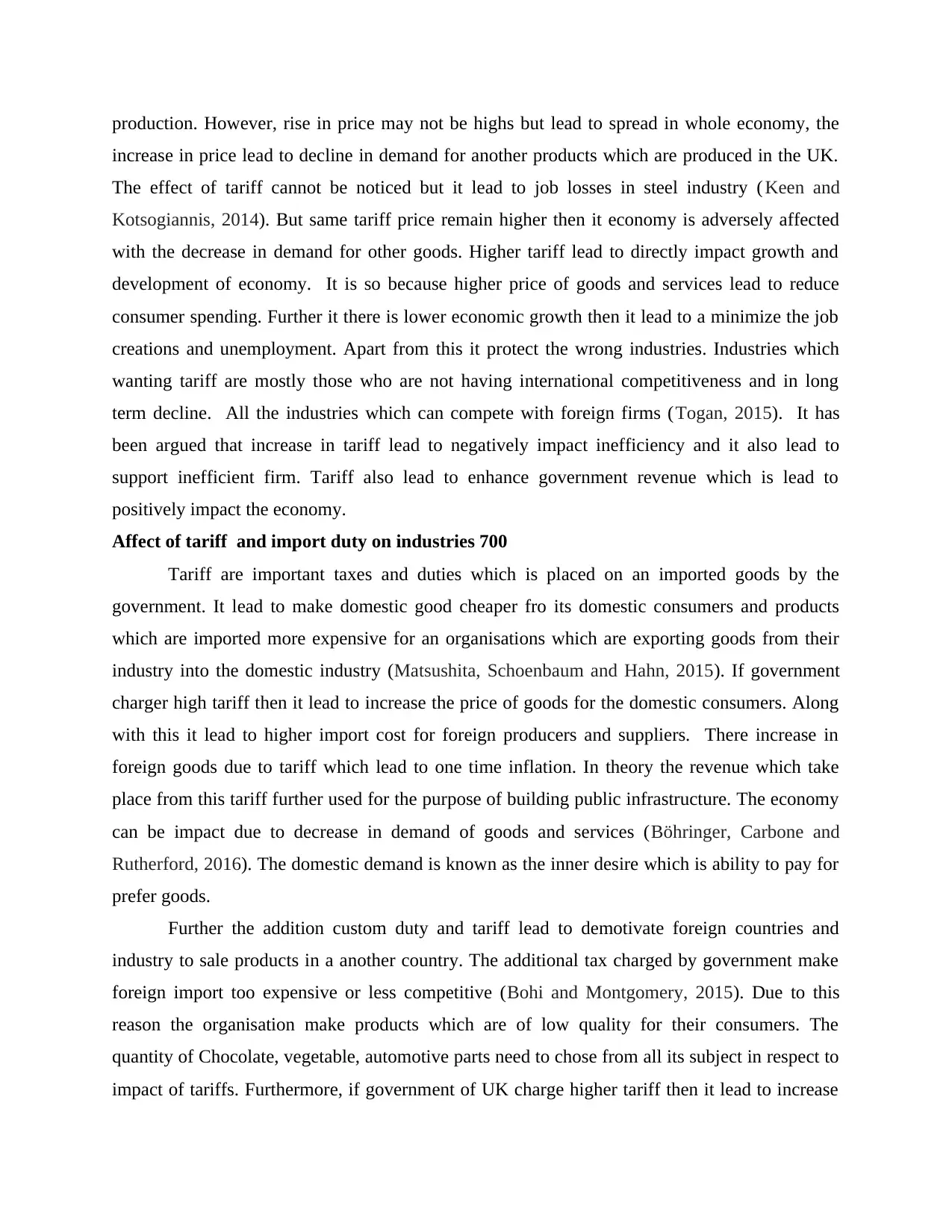
production. However, rise in price may not be highs but lead to spread in whole economy, the
increase in price lead to decline in demand for another products which are produced in the UK.
The effect of tariff cannot be noticed but it lead to job losses in steel industry ( Keen and
Kotsogiannis, 2014). But same tariff price remain higher then it economy is adversely affected
with the decrease in demand for other goods. Higher tariff lead to directly impact growth and
development of economy. It is so because higher price of goods and services lead to reduce
consumer spending. Further it there is lower economic growth then it lead to a minimize the job
creations and unemployment. Apart from this it protect the wrong industries. Industries which
wanting tariff are mostly those who are not having international competitiveness and in long
term decline. All the industries which can compete with foreign firms (Togan, 2015). It has
been argued that increase in tariff lead to negatively impact inefficiency and it also lead to
support inefficient firm. Tariff also lead to enhance government revenue which is lead to
positively impact the economy.
Affect of tariff and import duty on industries 700
Tariff are important taxes and duties which is placed on an imported goods by the
government. It lead to make domestic good cheaper fro its domestic consumers and products
which are imported more expensive for an organisations which are exporting goods from their
industry into the domestic industry (Matsushita, Schoenbaum and Hahn, 2015). If government
charger high tariff then it lead to increase the price of goods for the domestic consumers. Along
with this it lead to higher import cost for foreign producers and suppliers. There increase in
foreign goods due to tariff which lead to one time inflation. In theory the revenue which take
place from this tariff further used for the purpose of building public infrastructure. The economy
can be impact due to decrease in demand of goods and services (Böhringer, Carbone and
Rutherford, 2016). The domestic demand is known as the inner desire which is ability to pay for
prefer goods.
Further the addition custom duty and tariff lead to demotivate foreign countries and
industry to sale products in a another country. The additional tax charged by government make
foreign import too expensive or less competitive (Bohi and Montgomery, 2015). Due to this
reason the organisation make products which are of low quality for their consumers. The
quantity of Chocolate, vegetable, automotive parts need to chose from all its subject in respect to
impact of tariffs. Furthermore, if government of UK charge higher tariff then it lead to increase
increase in price lead to decline in demand for another products which are produced in the UK.
The effect of tariff cannot be noticed but it lead to job losses in steel industry ( Keen and
Kotsogiannis, 2014). But same tariff price remain higher then it economy is adversely affected
with the decrease in demand for other goods. Higher tariff lead to directly impact growth and
development of economy. It is so because higher price of goods and services lead to reduce
consumer spending. Further it there is lower economic growth then it lead to a minimize the job
creations and unemployment. Apart from this it protect the wrong industries. Industries which
wanting tariff are mostly those who are not having international competitiveness and in long
term decline. All the industries which can compete with foreign firms (Togan, 2015). It has
been argued that increase in tariff lead to negatively impact inefficiency and it also lead to
support inefficient firm. Tariff also lead to enhance government revenue which is lead to
positively impact the economy.
Affect of tariff and import duty on industries 700
Tariff are important taxes and duties which is placed on an imported goods by the
government. It lead to make domestic good cheaper fro its domestic consumers and products
which are imported more expensive for an organisations which are exporting goods from their
industry into the domestic industry (Matsushita, Schoenbaum and Hahn, 2015). If government
charger high tariff then it lead to increase the price of goods for the domestic consumers. Along
with this it lead to higher import cost for foreign producers and suppliers. There increase in
foreign goods due to tariff which lead to one time inflation. In theory the revenue which take
place from this tariff further used for the purpose of building public infrastructure. The economy
can be impact due to decrease in demand of goods and services (Böhringer, Carbone and
Rutherford, 2016). The domestic demand is known as the inner desire which is ability to pay for
prefer goods.
Further the addition custom duty and tariff lead to demotivate foreign countries and
industry to sale products in a another country. The additional tax charged by government make
foreign import too expensive or less competitive (Bohi and Montgomery, 2015). Due to this
reason the organisation make products which are of low quality for their consumers. The
quantity of Chocolate, vegetable, automotive parts need to chose from all its subject in respect to
impact of tariffs. Furthermore, if government of UK charge higher tariff then it lead to increase
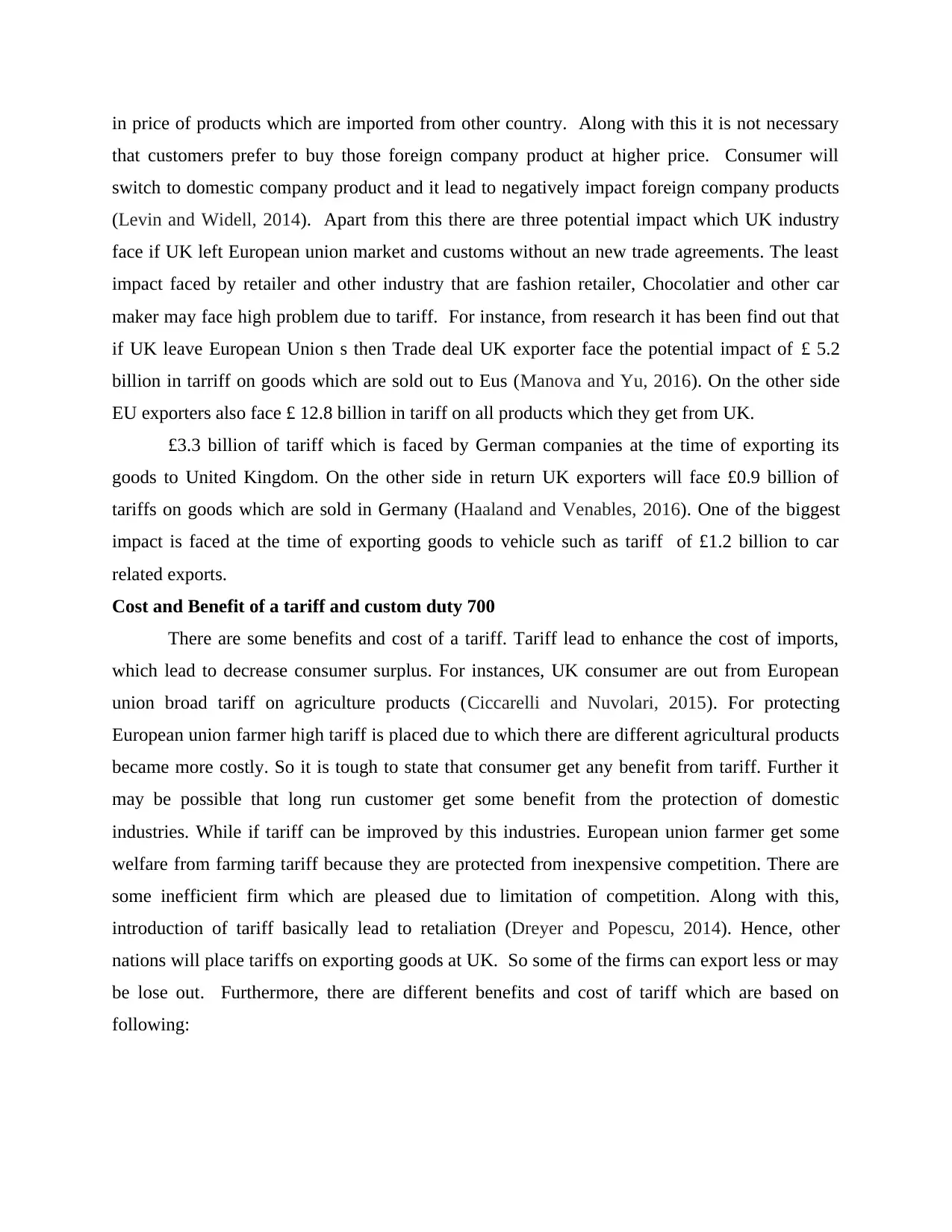
in price of products which are imported from other country. Along with this it is not necessary
that customers prefer to buy those foreign company product at higher price. Consumer will
switch to domestic company product and it lead to negatively impact foreign company products
(Levin and Widell, 2014). Apart from this there are three potential impact which UK industry
face if UK left European union market and customs without an new trade agreements. The least
impact faced by retailer and other industry that are fashion retailer, Chocolatier and other car
maker may face high problem due to tariff. For instance, from research it has been find out that
if UK leave European Union s then Trade deal UK exporter face the potential impact of £ 5.2
billion in tarriff on goods which are sold out to Eus (Manova and Yu, 2016). On the other side
EU exporters also face £ 12.8 billion in tariff on all products which they get from UK.
£3.3 billion of tariff which is faced by German companies at the time of exporting its
goods to United Kingdom. On the other side in return UK exporters will face £0.9 billion of
tariffs on goods which are sold in Germany (Haaland and Venables, 2016). One of the biggest
impact is faced at the time of exporting goods to vehicle such as tariff of £1.2 billion to car
related exports.
Cost and Benefit of a tariff and custom duty 700
There are some benefits and cost of a tariff. Tariff lead to enhance the cost of imports,
which lead to decrease consumer surplus. For instances, UK consumer are out from European
union broad tariff on agriculture products (Ciccarelli and Nuvolari, 2015). For protecting
European union farmer high tariff is placed due to which there are different agricultural products
became more costly. So it is tough to state that consumer get any benefit from tariff. Further it
may be possible that long run customer get some benefit from the protection of domestic
industries. While if tariff can be improved by this industries. European union farmer get some
welfare from farming tariff because they are protected from inexpensive competition. There are
some inefficient firm which are pleased due to limitation of competition. Along with this,
introduction of tariff basically lead to retaliation (Dreyer and Popescu, 2014). Hence, other
nations will place tariffs on exporting goods at UK. So some of the firms can export less or may
be lose out. Furthermore, there are different benefits and cost of tariff which are based on
following:
that customers prefer to buy those foreign company product at higher price. Consumer will
switch to domestic company product and it lead to negatively impact foreign company products
(Levin and Widell, 2014). Apart from this there are three potential impact which UK industry
face if UK left European union market and customs without an new trade agreements. The least
impact faced by retailer and other industry that are fashion retailer, Chocolatier and other car
maker may face high problem due to tariff. For instance, from research it has been find out that
if UK leave European Union s then Trade deal UK exporter face the potential impact of £ 5.2
billion in tarriff on goods which are sold out to Eus (Manova and Yu, 2016). On the other side
EU exporters also face £ 12.8 billion in tariff on all products which they get from UK.
£3.3 billion of tariff which is faced by German companies at the time of exporting its
goods to United Kingdom. On the other side in return UK exporters will face £0.9 billion of
tariffs on goods which are sold in Germany (Haaland and Venables, 2016). One of the biggest
impact is faced at the time of exporting goods to vehicle such as tariff of £1.2 billion to car
related exports.
Cost and Benefit of a tariff and custom duty 700
There are some benefits and cost of a tariff. Tariff lead to enhance the cost of imports,
which lead to decrease consumer surplus. For instances, UK consumer are out from European
union broad tariff on agriculture products (Ciccarelli and Nuvolari, 2015). For protecting
European union farmer high tariff is placed due to which there are different agricultural products
became more costly. So it is tough to state that consumer get any benefit from tariff. Further it
may be possible that long run customer get some benefit from the protection of domestic
industries. While if tariff can be improved by this industries. European union farmer get some
welfare from farming tariff because they are protected from inexpensive competition. There are
some inefficient firm which are pleased due to limitation of competition. Along with this,
introduction of tariff basically lead to retaliation (Dreyer and Popescu, 2014). Hence, other
nations will place tariffs on exporting goods at UK. So some of the firms can export less or may
be lose out. Furthermore, there are different benefits and cost of tariff which are based on
following:
⊘ This is a preview!⊘
Do you want full access?
Subscribe today to unlock all pages.

Trusted by 1+ million students worldwide
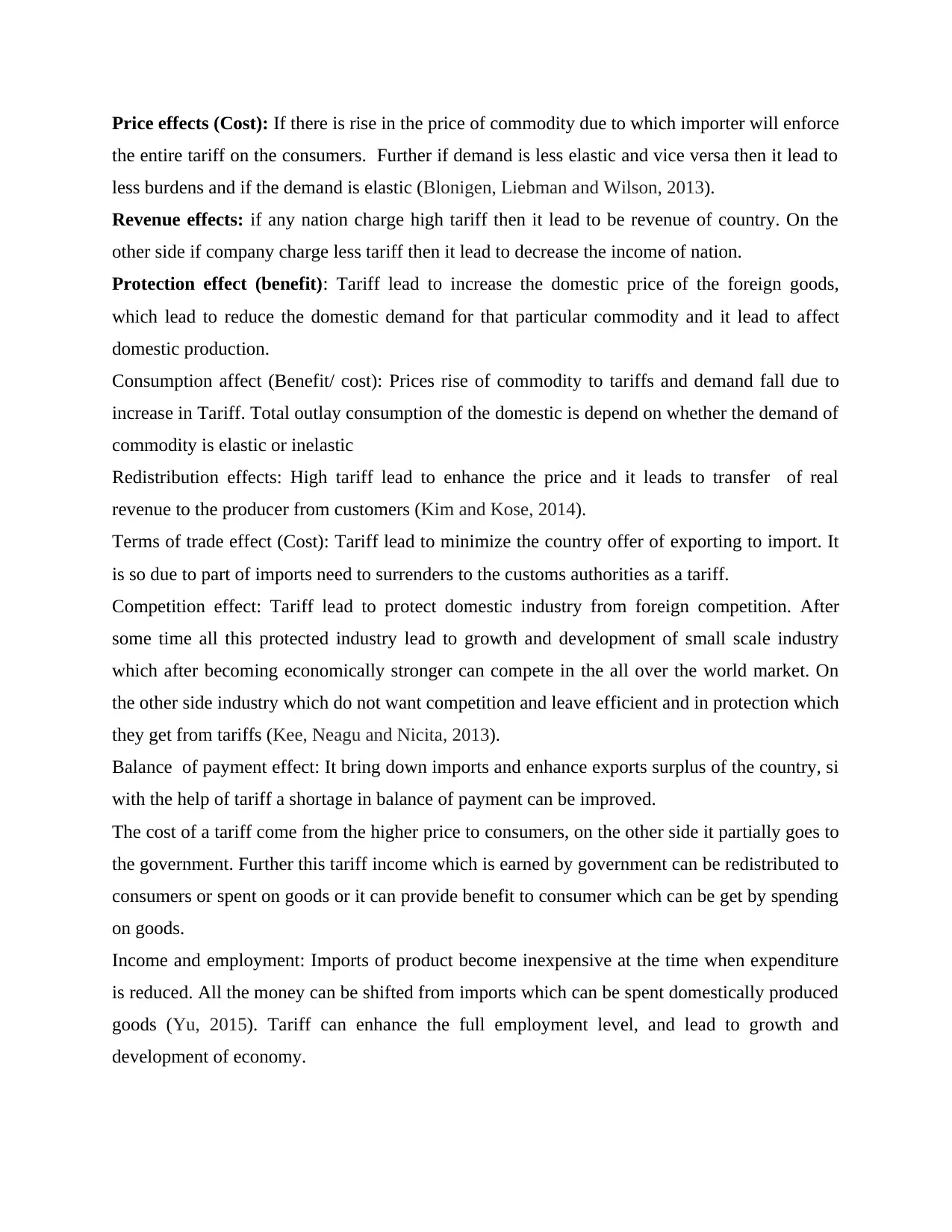
Price effects (Cost): If there is rise in the price of commodity due to which importer will enforce
the entire tariff on the consumers. Further if demand is less elastic and vice versa then it lead to
less burdens and if the demand is elastic (Blonigen, Liebman and Wilson, 2013).
Revenue effects: if any nation charge high tariff then it lead to be revenue of country. On the
other side if company charge less tariff then it lead to decrease the income of nation.
Protection effect (benefit): Tariff lead to increase the domestic price of the foreign goods,
which lead to reduce the domestic demand for that particular commodity and it lead to affect
domestic production.
Consumption affect (Benefit/ cost): Prices rise of commodity to tariffs and demand fall due to
increase in Tariff. Total outlay consumption of the domestic is depend on whether the demand of
commodity is elastic or inelastic
Redistribution effects: High tariff lead to enhance the price and it leads to transfer of real
revenue to the producer from customers (Kim and Kose, 2014).
Terms of trade effect (Cost): Tariff lead to minimize the country offer of exporting to import. It
is so due to part of imports need to surrenders to the customs authorities as a tariff.
Competition effect: Tariff lead to protect domestic industry from foreign competition. After
some time all this protected industry lead to growth and development of small scale industry
which after becoming economically stronger can compete in the all over the world market. On
the other side industry which do not want competition and leave efficient and in protection which
they get from tariffs (Kee, Neagu and Nicita, 2013).
Balance of payment effect: It bring down imports and enhance exports surplus of the country, si
with the help of tariff a shortage in balance of payment can be improved.
The cost of a tariff come from the higher price to consumers, on the other side it partially goes to
the government. Further this tariff income which is earned by government can be redistributed to
consumers or spent on goods or it can provide benefit to consumer which can be get by spending
on goods.
Income and employment: Imports of product become inexpensive at the time when expenditure
is reduced. All the money can be shifted from imports which can be spent domestically produced
goods (Yu, 2015). Tariff can enhance the full employment level, and lead to growth and
development of economy.
the entire tariff on the consumers. Further if demand is less elastic and vice versa then it lead to
less burdens and if the demand is elastic (Blonigen, Liebman and Wilson, 2013).
Revenue effects: if any nation charge high tariff then it lead to be revenue of country. On the
other side if company charge less tariff then it lead to decrease the income of nation.
Protection effect (benefit): Tariff lead to increase the domestic price of the foreign goods,
which lead to reduce the domestic demand for that particular commodity and it lead to affect
domestic production.
Consumption affect (Benefit/ cost): Prices rise of commodity to tariffs and demand fall due to
increase in Tariff. Total outlay consumption of the domestic is depend on whether the demand of
commodity is elastic or inelastic
Redistribution effects: High tariff lead to enhance the price and it leads to transfer of real
revenue to the producer from customers (Kim and Kose, 2014).
Terms of trade effect (Cost): Tariff lead to minimize the country offer of exporting to import. It
is so due to part of imports need to surrenders to the customs authorities as a tariff.
Competition effect: Tariff lead to protect domestic industry from foreign competition. After
some time all this protected industry lead to growth and development of small scale industry
which after becoming economically stronger can compete in the all over the world market. On
the other side industry which do not want competition and leave efficient and in protection which
they get from tariffs (Kee, Neagu and Nicita, 2013).
Balance of payment effect: It bring down imports and enhance exports surplus of the country, si
with the help of tariff a shortage in balance of payment can be improved.
The cost of a tariff come from the higher price to consumers, on the other side it partially goes to
the government. Further this tariff income which is earned by government can be redistributed to
consumers or spent on goods or it can provide benefit to consumer which can be get by spending
on goods.
Income and employment: Imports of product become inexpensive at the time when expenditure
is reduced. All the money can be shifted from imports which can be spent domestically produced
goods (Yu, 2015). Tariff can enhance the full employment level, and lead to growth and
development of economy.
Paraphrase This Document
Need a fresh take? Get an instant paraphrase of this document with our AI Paraphraser
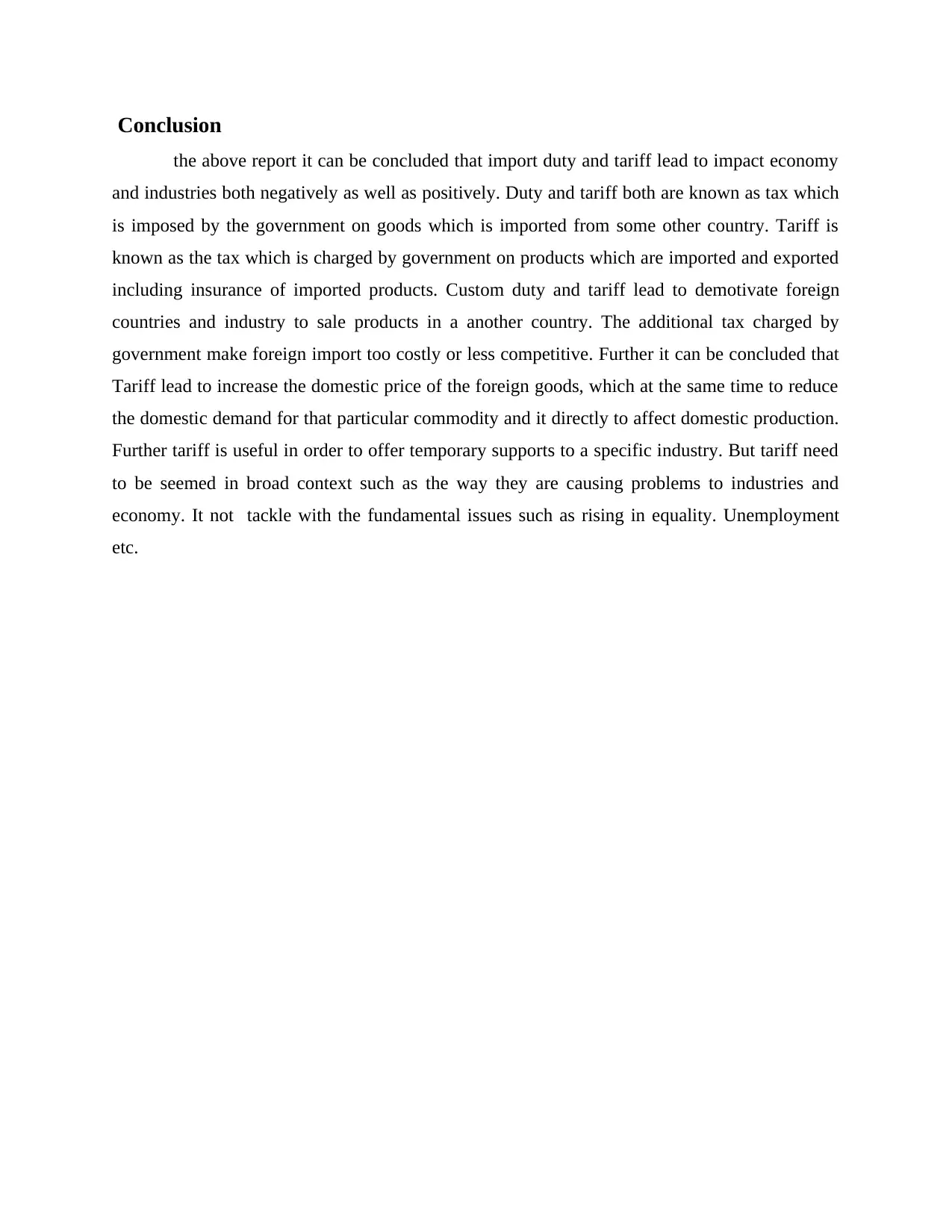
Conclusion
the above report it can be concluded that import duty and tariff lead to impact economy
and industries both negatively as well as positively. Duty and tariff both are known as tax which
is imposed by the government on goods which is imported from some other country. Tariff is
known as the tax which is charged by government on products which are imported and exported
including insurance of imported products. Custom duty and tariff lead to demotivate foreign
countries and industry to sale products in a another country. The additional tax charged by
government make foreign import too costly or less competitive. Further it can be concluded that
Tariff lead to increase the domestic price of the foreign goods, which at the same time to reduce
the domestic demand for that particular commodity and it directly to affect domestic production.
Further tariff is useful in order to offer temporary supports to a specific industry. But tariff need
to be seemed in broad context such as the way they are causing problems to industries and
economy. It not tackle with the fundamental issues such as rising in equality. Unemployment
etc.
the above report it can be concluded that import duty and tariff lead to impact economy
and industries both negatively as well as positively. Duty and tariff both are known as tax which
is imposed by the government on goods which is imported from some other country. Tariff is
known as the tax which is charged by government on products which are imported and exported
including insurance of imported products. Custom duty and tariff lead to demotivate foreign
countries and industry to sale products in a another country. The additional tax charged by
government make foreign import too costly or less competitive. Further it can be concluded that
Tariff lead to increase the domestic price of the foreign goods, which at the same time to reduce
the domestic demand for that particular commodity and it directly to affect domestic production.
Further tariff is useful in order to offer temporary supports to a specific industry. But tariff need
to be seemed in broad context such as the way they are causing problems to industries and
economy. It not tackle with the fundamental issues such as rising in equality. Unemployment
etc.
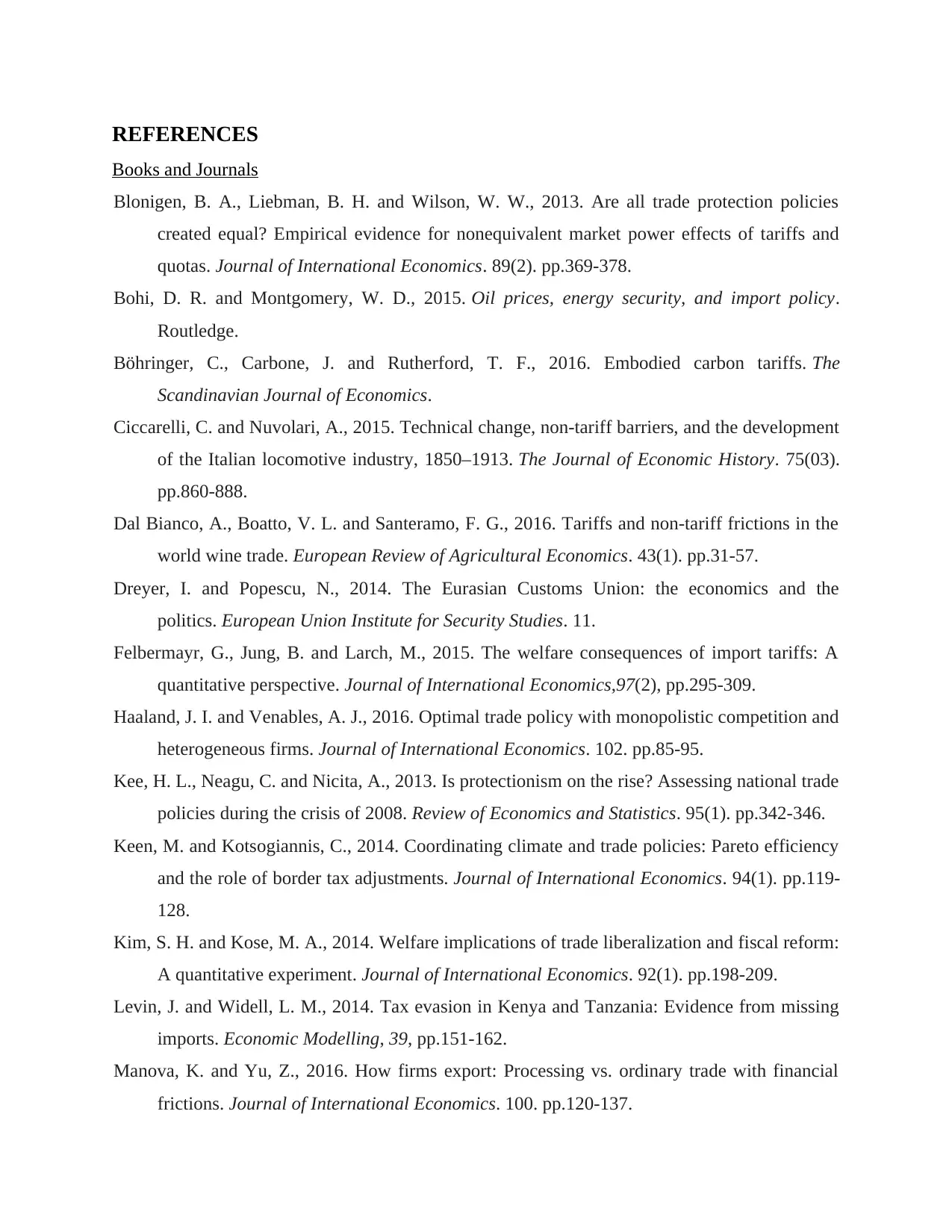
REFERENCES
Books and Journals
Blonigen, B. A., Liebman, B. H. and Wilson, W. W., 2013. Are all trade protection policies
created equal? Empirical evidence for nonequivalent market power effects of tariffs and
quotas. Journal of International Economics. 89(2). pp.369-378.
Bohi, D. R. and Montgomery, W. D., 2015. Oil prices, energy security, and import policy.
Routledge.
Böhringer, C., Carbone, J. and Rutherford, T. F., 2016. Embodied carbon tariffs. The
Scandinavian Journal of Economics.
Ciccarelli, C. and Nuvolari, A., 2015. Technical change, non-tariff barriers, and the development
of the Italian locomotive industry, 1850–1913. The Journal of Economic History. 75(03).
pp.860-888.
Dal Bianco, A., Boatto, V. L. and Santeramo, F. G., 2016. Tariffs and non-tariff frictions in the
world wine trade. European Review of Agricultural Economics. 43(1). pp.31-57.
Dreyer, I. and Popescu, N., 2014. The Eurasian Customs Union: the economics and the
politics. European Union Institute for Security Studies. 11.
Felbermayr, G., Jung, B. and Larch, M., 2015. The welfare consequences of import tariffs: A
quantitative perspective. Journal of International Economics,97(2), pp.295-309.
Haaland, J. I. and Venables, A. J., 2016. Optimal trade policy with monopolistic competition and
heterogeneous firms. Journal of International Economics. 102. pp.85-95.
Kee, H. L., Neagu, C. and Nicita, A., 2013. Is protectionism on the rise? Assessing national trade
policies during the crisis of 2008. Review of Economics and Statistics. 95(1). pp.342-346.
Keen, M. and Kotsogiannis, C., 2014. Coordinating climate and trade policies: Pareto efficiency
and the role of border tax adjustments. Journal of International Economics. 94(1). pp.119-
128.
Kim, S. H. and Kose, M. A., 2014. Welfare implications of trade liberalization and fiscal reform:
A quantitative experiment. Journal of International Economics. 92(1). pp.198-209.
Levin, J. and Widell, L. M., 2014. Tax evasion in Kenya and Tanzania: Evidence from missing
imports. Economic Modelling, 39, pp.151-162.
Manova, K. and Yu, Z., 2016. How firms export: Processing vs. ordinary trade with financial
frictions. Journal of International Economics. 100. pp.120-137.
Books and Journals
Blonigen, B. A., Liebman, B. H. and Wilson, W. W., 2013. Are all trade protection policies
created equal? Empirical evidence for nonequivalent market power effects of tariffs and
quotas. Journal of International Economics. 89(2). pp.369-378.
Bohi, D. R. and Montgomery, W. D., 2015. Oil prices, energy security, and import policy.
Routledge.
Böhringer, C., Carbone, J. and Rutherford, T. F., 2016. Embodied carbon tariffs. The
Scandinavian Journal of Economics.
Ciccarelli, C. and Nuvolari, A., 2015. Technical change, non-tariff barriers, and the development
of the Italian locomotive industry, 1850–1913. The Journal of Economic History. 75(03).
pp.860-888.
Dal Bianco, A., Boatto, V. L. and Santeramo, F. G., 2016. Tariffs and non-tariff frictions in the
world wine trade. European Review of Agricultural Economics. 43(1). pp.31-57.
Dreyer, I. and Popescu, N., 2014. The Eurasian Customs Union: the economics and the
politics. European Union Institute for Security Studies. 11.
Felbermayr, G., Jung, B. and Larch, M., 2015. The welfare consequences of import tariffs: A
quantitative perspective. Journal of International Economics,97(2), pp.295-309.
Haaland, J. I. and Venables, A. J., 2016. Optimal trade policy with monopolistic competition and
heterogeneous firms. Journal of International Economics. 102. pp.85-95.
Kee, H. L., Neagu, C. and Nicita, A., 2013. Is protectionism on the rise? Assessing national trade
policies during the crisis of 2008. Review of Economics and Statistics. 95(1). pp.342-346.
Keen, M. and Kotsogiannis, C., 2014. Coordinating climate and trade policies: Pareto efficiency
and the role of border tax adjustments. Journal of International Economics. 94(1). pp.119-
128.
Kim, S. H. and Kose, M. A., 2014. Welfare implications of trade liberalization and fiscal reform:
A quantitative experiment. Journal of International Economics. 92(1). pp.198-209.
Levin, J. and Widell, L. M., 2014. Tax evasion in Kenya and Tanzania: Evidence from missing
imports. Economic Modelling, 39, pp.151-162.
Manova, K. and Yu, Z., 2016. How firms export: Processing vs. ordinary trade with financial
frictions. Journal of International Economics. 100. pp.120-137.
⊘ This is a preview!⊘
Do you want full access?
Subscribe today to unlock all pages.

Trusted by 1+ million students worldwide
1 out of 13
Related Documents
Your All-in-One AI-Powered Toolkit for Academic Success.
+13062052269
info@desklib.com
Available 24*7 on WhatsApp / Email
![[object Object]](/_next/static/media/star-bottom.7253800d.svg)
Unlock your academic potential
Copyright © 2020–2025 A2Z Services. All Rights Reserved. Developed and managed by ZUCOL.





